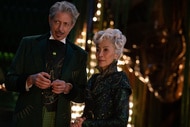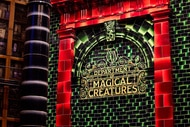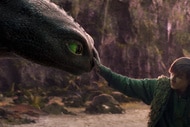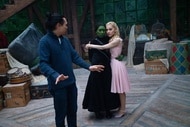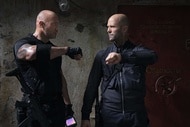Create a free profile to get unlimited access to exclusive videos, sweepstakes, and more!
'Beast' director talks Idris Elba's lion fight and origin of that 'Jurassic Park' Easter egg
Beast, which stars Idris Elba and a big mean lion, is now playing in theaters everywhere.

Until the release of Beast this past weekend, we never knew we wanted to see Idris Elba square off with a massive, revenge-fueled lion on the big screen.
It's like Arnold Schwarzenegger outsmarting the Yautja in the original Predator or Liam Neeson engaging a wolf to fisticuffs in The Grey — it scratches that primal itch in our brains as we constantly find it necessary to reassure ourselves that we are indeed the dominant species on this planet. That nagging insecurity over who truly rules the natural world continues to erode with humanity's mistreatment of the environment and in the end, of course, no one really wins. If our species can't find a way to live in genuine harmony with nature... well, nature will always do what it does: break free (as Ian Malcolm once said) and show us all who is really calling the shots around here.
While Elba could not share the screen with an actual man-eater for insurance purposes, Beast director Baltasar Kormákur (known for tense man vs. nature survival thrillers like Everest and Adrift) worked hard to make sure that all of the big cat action felt as real as possible. "One of the things that is very important to me is gravity when it comes to VFX [which] I think [is] often lacking," the filmmaker tells SYFY WIRE over Zoom. "The connection is in weight and how Idris is pulled or pushed or when the lion hits the car — it has [to have] the right weight. Those things were very important to me and we worked deeply [to get that right]."
He continues: "I’ve been around animals all my life. [I know about] the muscles, the details of anatomy, of how an animal moves. We went into incredible details to give you the feeling that you are actually having a real lion attacking you on screen. I also didn't want to make it too big, I didn't want to make it bloated. I wanted it to be mean and sharp and unpredictable. That was really the choice."
Kormákur didn't just want a mindless movie monster audiences would instantly forget once the credits began to roll — he wanted the lion to feel like another member of the main cast, "to create a character on the screen," the director adds. "It wasn't enough just to [have] any lion, it needed to be a specific lion and we used references for that, and lions that I found had really specific features. So all these things and then how it developed through [the movie] with more wounds and then the burn. A lot of work that went into that."
The final creature was a CGI creation, but its presence on set was thoroughly old school with "a guy in a lion suit." The performer had intimate knowledge of the savannah's apex predator as "his parents had some lands [where] they raised [lions]."
"He really knew how the lions go about," states the director. "We were very specific about it because once you get into this one shot, idea, structure, you are kind of stuck in it. You have to get the pace, the reactions, everything right because you can’t alter it much in post once you’ve shot it. So having someone like that … was a tremendous help and just being a lion in some capacity while we were shooting. Of course, we had to take it all out and then add our own [lion], but it is important that you have something to play against. He also needed to be quite strong and we needed to be very specific about how he moved Idris, so the weight of the lion would come through [in the finished product]."
Clocking in at a tight 93 minutes, Beast tells the story of Dr. Nate Samuels (Elba), an American physician who travels to South Africa with his two young daughters — Meredith (Iyana Halley) and Norah (Leah Jeffries) — after the tragic passing of his wife from whom he was separated. While touring a nearby reserve with an old friend, wildlife biologist Martin Battles (played by District 9 alum, Sharlto Copley), Nate and his children suddenly find themselves locked in a life or death battle for survival, trying to evade an out-of-control lion seeking revenge for the death of its pride at the hands of greedy poachers.
With its overarching themes of broken families and nature striking back, the movie immediately brings to mind Steven Spielberg's Jurassic Park (also distributed by Universal Pictures). Kormákur and his costume designer — Namibia native Moira Anne Meyer (Of Kings and Prophets, Warrior) — lean into this parallel early on with a Jurassic Park shirt Meredith wears just before the characters embark on a deadly safari.
"It's a little play with the iconography of cinema," the director says of the Easter egg, which also serves as a nice bit of foreshadowing. "It didn't come from the studio, there was no one asking us to put this on, just to make that clear. That was an artistic choice by the costume designer, which I agreed [with]. I like that little wink [to the audience]."
And just as Alan Grant learns to accept the joy of raising children, so too does Dr. Samuels get a chance to emotionally reconnect with daughters who blame him for abandoning their mother in a time when she needed him most. Nate doesn't deny the guilt, allowing his grief and remorse to eat him alive in the same way a lion devours its prey. In other words, the titular entity at the heart of the film represents so much more than just the uncaring ferocity of nature.
"For me, the beast represents the hardest challenge that I have faced in my life to get my family back together, all the children back in line, recreate the relationships with them, and move on," Kormákur explains. "I think, in some ways, that's what appealed to me, the human element of it. As you said, that is the metaphor of the challenge that he's going through. He's taking them back to their mother's place [of origin] and he has to face the nature of it and the legacy of it in a way to earn the trust of his daughters. But I also like the fact that the daughters start to come in and help and be more like a family. I love the messiness of it and how they start working together. That's how families function, and it’s one of the most complicated things we deal with in our lives, is to maintain a strong and good family."
Audiences, Kormákur reckoned, would come for the rampaging lion, but stay for the relatable stakes:
"The family dynamic and relationship was important to withstand the quieter moments; being invested in them and wanting them to get through it together was very important. So we give them a little bit of time in the beginning. But I also think feeling the moment, having the audience feel like they’re stuck there with the characters, having [the lion] coming at you — you don't know where it's coming gonna come from next. I tried to keep the momentum of the film going and the unpredictability of when you're in this shot, it just feels like you never know where it's gonna come from. I've done films like Everest with a huge amount of characters and masks and snowstorms. To be able to be in a smaller timeframe and character gallery allows for a lot of filmmaking at the same time, which I welcomed."
Nate ultimately confronts the emotional burden weighing on his shoulders in the movie's thrilling climax, a Samson-esque set piece where our protagonist goes head-to-head with the vindictive lion without the use of rifle or tranquilizer darts. "The challenge was that we needed to cover a full fight for two minutes or more in every aspect of it and get the camera in the right places and then imagine how the lion would move around and give it time and still keep the tension," he reveals. "It was a really, really intense shoot, but we started prepping that as early as we had Idris [attached]. It was the last thing we shot in Africa before we went back to Cape Town ... Idris was very keen to spend a lot of time getting that right. He knew how important that scene was going to be. We had South African talents helping us, great VFX people and stunt people. It was a long journey."
Talking the studio into allowing the project to receive an R-rating was "a challenge," but went a long way in achieving that aforementioned sense of realism. "It's always tempting to go PG-13 on a film like this ... What I really wanted was to make it visceral," the director says, adding that he didn't want to make the lion mauling violence too explicit to the point where it became overly gratuitous. "We were looking for the balance ... not to overdo the gore. And also, it needs to be believable that Nate survives this. We looked at wounds and stuff like that, and some people might think it’s far-fetched, but it's not, really. There are a lot of survivors from these attacks as well."
Presenting an accurate and respectful depiction of South African culture — especially when it came to the Venda language and customs of Nate's ex-wife — was also of the utmost importance. "The mother and all the other cast [members are], more or less, South African and we tried to bring as much [authenticity as we could like] the Venda language. None of this was in the script in the beginning, it's all something that we found out and went deeper into by digging into the country of South Africa."
Beast is now playing in theaters everywhere.

